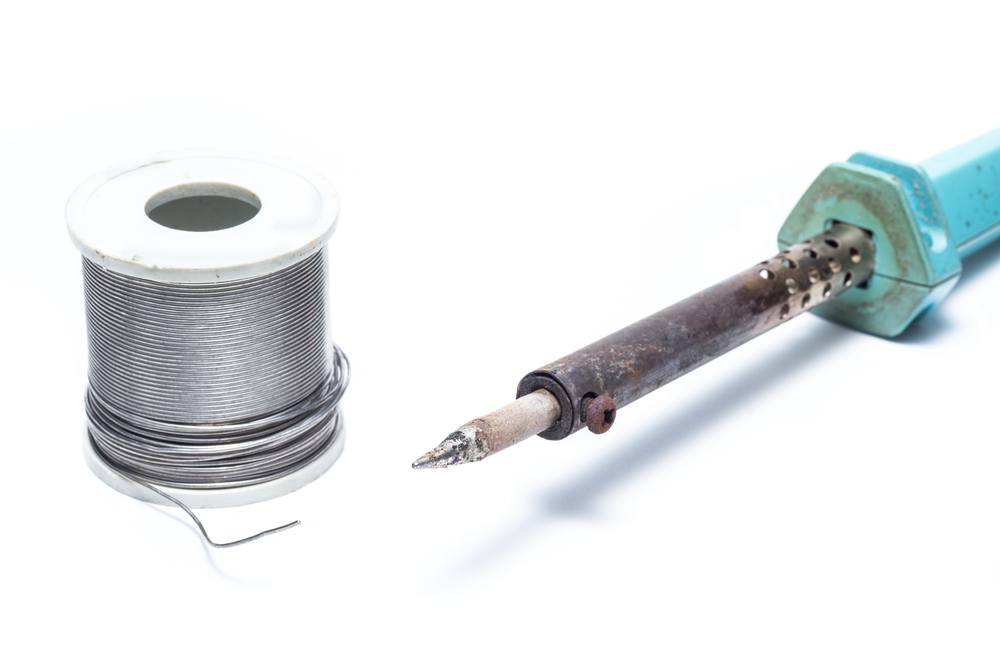
The tip is a critical component in any soldering project. It ensures heat is transferred efficiently and reliably to the surface. Proper care and maintenance is essential to ensure the tip transfers heat efficiently while extending its life. However, after prolonged use, the tip is likely to grow dull, especially if you have been working on multiple projects.
The best way to restore the tip is by re-tinning. It is the process of applying a thin layer of solder to create a protective layer between the iron and the air. Soldering tips are made of copper base material and coated with iron to prevent erosion.
Iron, however, oxidizes rapidly, leaving the copper material exposed.
When oxidation occurs, the tip develops a brown or black scale, which does not wet when the solder is applied. As a result, heat transfer is significantly compromised, a condition known as burn out. Some users will discard burned out tips, but they can be retinned to restore their original luster. Here’s how to do it:
Tools Required
- Solder
- Dirty tip
- Wet sponge
Tip cleaner
Procedure
Clean the Tip
Tinning is more effective when done on a clean tip. Use a damp sponge to clean the tip and wipe it off quickly to avoid cooling the tip excessively. You can also use stainless steel, pot scrubber as long as it is dry to prevent transmitting the heat.
Apart from removing the flux off, it is essential to clean off surplus solder. Modern cleaning methods involve the use of soft metal shavings pot. These cleaning agents do not have the cooling effect that the wet sponge creates. They also avoid the thermal shock produced by wet sponges extending the life of the tip.
Tin the Tip
Apply new solder on the newly cleaned tip. Mildly active rosin-core (0.5-0.98 mm) with 60/40 or 63/37 Tin/Lead content works best. Solder with a small diameter is ideal when working on double-sided PC boards that have plated-thru holes. This is because it allows you to control the amount of solder applied to the tip.
A solder with a small amount of solver content is suitable for projects that need a better flow of solder, and if you want to create strong joints. However, silver-based solder requires more heat and is difficult to remove when de-soldering the joint for component placement.
Additional Ways of Restoring the Tip
Apply a Tip Tinner
If the tip is a little too dirty, you can apply a cleaning paste and a tip tinner. It is a much stronger flux that will clean and tin the tip. A simple dab on the tip should do the job.
Alternatively, you can use a special polishing bar, particularly of the tip is corroded or extremely dirty. Be sure not to scape off the tip too aggressively as you may remove the plating. As mentioned earlier, soldering tips are made of copper, which dissolves rapidly in the solder if left exposed. Follow it up with a thin layer of solder to avoid oxidation.
Using Sal Ammoniac Tinning Block
If the tip is dirty and excessively oxidized, you can also use a sal ammoniac tinning block to bring it to life. You need to rub the tip on the block while rotating it. The tip smokes and melts into the block, and you should apply solder to tip at this point. Be sure to use the block in a well-ventilated area as it gives off fumes.
Using Flux
It is a substance that dissolves the metal oxide. It dissolves the metal oxide allowing it to evaporate when the flux attains a boiling point. The flux may be in the form of a soldering wire or paste form.
You should avoid using water-soluble fluxes as they damage tips at high temperatures. Water-soluble fluxes are ideal for wave soldering projects and are often followed up by a full cleaning to remove excess flux residue.
No-clean flux is also not ideal for tinning soldering tips. The substance is primarily designed for soldering very clean parts where minimal cleaning is required. As such, they can’t remove metal oxides effectively. If used, the tip becomes oxidized after a short period of use. Additionally, it exhibits a burn-out appearance and does not wet with solder adequately.
